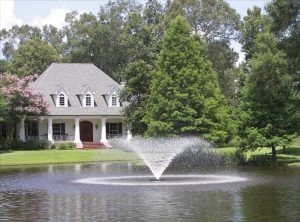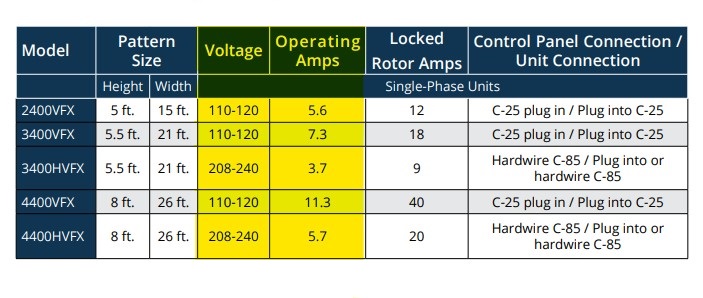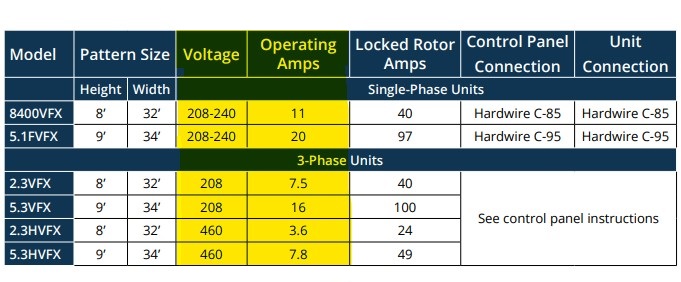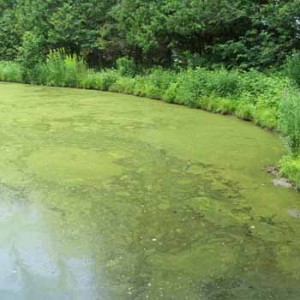8 Myths Busted on Fountains & Aeration
Myth # 1: 240V is Cheaper to Operate than 120V
- All comes down to AMPS
- Volts x Amps = Watts (you pay for watts)
- Amps on 240V equipment are roughly ½ that of 120V
- Ex. 3400VFX vs. 3400HVFX
7.3 x 120 = 876 watts or .876kW = $0.07 per hour ($.08/kWh)
3.7 x 240 = 888 watts or .888kW = $0.071 per hour ($.08/kWh)
However:
- You do pay more for 240V controllers and power cords
- You do need larger (more costly) gauge cords for 240V
In conclusion, 120V is often cheaper to buy than 240V, and for units of 1HP or less, cost about the same in electricity. Choose 240V only if that’s what you already have available on site for these small units.
Use what you have. If you need to run power, figure out what else you may use from that circuit.
See below for the fountain manufacturer’s reference charts on voltages and amperage during use.


Myth # 2: Three-Phase is Cheaper to Operate than One-Phase
- Again, all comes down to AMPS
- Single Phase = V x A = Watts
- 3 Phase = V x A x 1.7 = Watts
- Ex: 5.1JF vs. 5.3JF
20 x 240 = 4,800 watts = $0.38 per hour ($.08/kWh)
16 x 230 x 1.7 = 6,256 watts = $0.50 per hour ($.08/kWh)
However:
- You can run smaller power gauge on 3 phase BUT it is 4 conductor cable
- 3 phase panels are more expensive
- You can run larger HP equipment on 3 phase than single phase economically
- 10hp + , 3 phase is more economical

Myth # 3: Bacteria and Aeration Kill Algae
- Neither will kill algae
- Together they remove organic nutrients and MAY out-compete some plants for those nutrients
- Create a healthier pond that can keep nutrients, plant growth, and organic matter in balance
- It’s not always easy to get rid of this sort of problem!
Myth # 4: Breaker Trips are Due to Water
- GFI Trip = Ground Fault
Typically from water entry: cut in the cable, poor splicing of cable, leak in the motor, poor grounding/bad neutral, Long UF wire runs – nuisance tripping
- Breaker Trip
Can be from too high of amps, clogged motor, poor voltage, short between live conductors
- Thermal Overload Trip
Can be from over heating of the motor caused from high amps, clogging, dirty motor can, faulty motor
Myth # 5: High Flow Means Better Aeration
- Aeration Efficiency is measured by oxygen transfer into the water per kW of power consumed
- Flow does NOT ALWAYS mean better aeration efficiency
- Look for SAE (Standard Aeration Efficiency) to determine how efficiently oxygen is being added to the water

Myth # 6: All HP’s are the Same
- Comes down to power consumed vs work performed
- Ex: 1HP Decorative Fountain
Kasco: 1HP, 4400JF = 11 amps @ 120V
Brand O: 1HP Aerating Fountain = 14 amps @ 120V
Brand A: 1HP Classic Series = 18 amps @ 120V
- Look for Amps to:
Determine power consumption
Compare pattern sizes
Myth # 7: All Published GPM’s (Gallons Per Minute) are Accurate
- There is no standard, industry wide test
- Some use induced flow
- Don’t assume all published numbers are tested the same way, or even tested at all
- Look at SAE (Standard Aeration Efficiency)
- Also consider Amp draw when comparing GPM
Myth # 8: High RPM (Rotations Per Minute) is More Efficient
- High RPM and Low RPM have their own advantages
- Low RPM: Typically lower amp draw and higher aeration efficiency
- High RPM: Typically able to produce higher pressure and higher, larger displays, but do have higher amp draw
We hope you learned interesting facts reading about these as we did and visit our online shop to purchase one!
Related content: